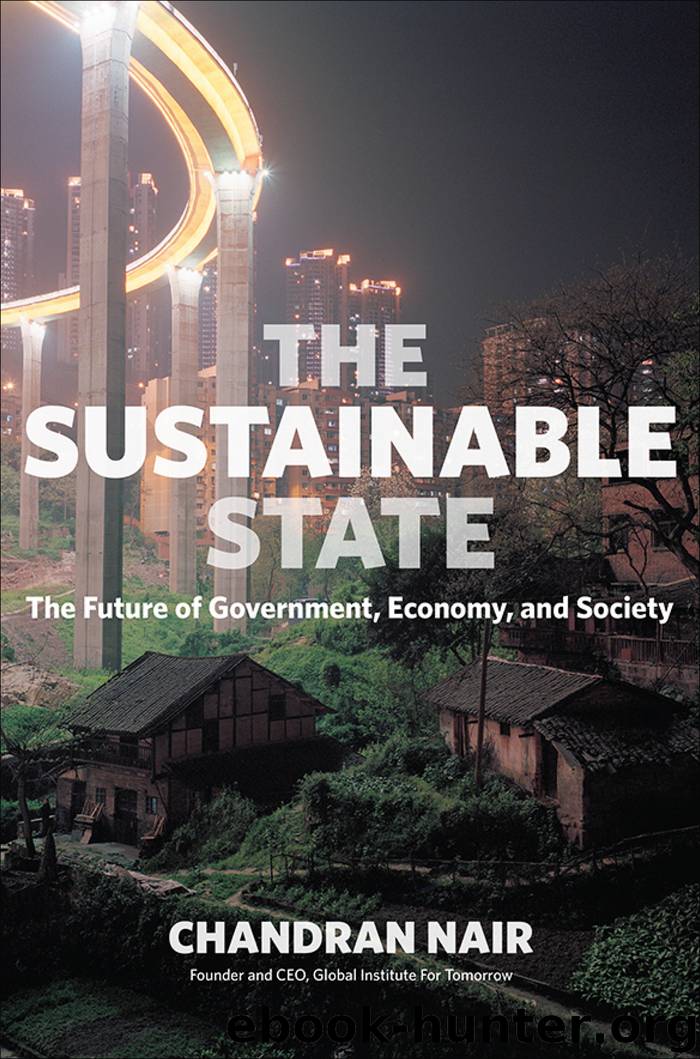The Sustainable State: The Future of Government, Economy, and Society by Chandran Nair

Author:Chandran Nair
Language: eng
Format: epub
Publisher: Berrett-Koehler Publishers, Inc.
Published: 2018-02-23T16:00:00+00:00
The Current View of Prosperity
In the Western economic model, which has been exported to the rest of the world, prosperity is equivalent to consumption. The more one consumes and owns, the more prosperous one is. In most societies, one’s status in the world goes up. This is true even if the consumption does not serve any real personal or social purpose or if people could achieve the same standard of living with less consumption or fewer resources.
In this model, prosperity is continuous, stretching out to infinity. This has led to a great deal of waste, of which consumption of clothing is a good example. In developed countries, the middle and upper classes own far more clothing than they feasibly could ever need. Having a large and varied wardrobe is seen as one of the symbols of prosperity. Singapore’s National Environment Agency estimated that, in 2015, Singapore threw out 156,700 tons of clothing and leather waste.4 A Greenpeace study of Hong Kong found that one-fifth of all clothes bought by residents were never worn, totaling almost US$512 million in wasted purchases.5
At the level of the individual, it doesn’t hurt consumers to buy more clothes than they need. These products are so cheap that even the extremely limited benefit of owning more clothing would still be greater than the price. But clothing is cheap for a reason: the massive underpricing of the resources (e.g., cotton, which has huge externalities as a crop) and labor that go into making them. One would expect that if clothing were priced more accurately, people would decide to buy far less of it and to try to preserve the clothing they already own. (And only then could fashion designers and the garment industry lay claim to any green credentials and give even an iota of legitimacy to their T-shirts with slogans about saving the planet.)
It is also clear that our current view of prosperity does not handle how long a product will last. When faced with the choice of buying multiple cheap products that will fail in a short period of time or buying one expensive product that will last a long time, many people will choose cheaper disposable goods. The market does not mind this behavior; in fact, it desires, cultivates, and thrives on it.
For example, the consumer electronics sector thrives on planned obsolescence, with companies producing faster and more powerful devices each year in the hope of driving new sales. The lifespan of these devices often extends far longer than the product cycle, yet companies encourage people to junk their existing devices and buy the newest. This leads to an increasing amount of e-waste, which is now plaguing landfills around the world. Worse, companies may even design products with the foreknowledge that people will replace them within a year or two, discouraging those companies from making reliable and optimized products. So much for “innovation.”
We often leave it to the consumer to define prosperity, because economic models often assume that people can rationally judge the costs and benefits of their decisions.
Download
This site does not store any files on its server. We only index and link to content provided by other sites. Please contact the content providers to delete copyright contents if any and email us, we'll remove relevant links or contents immediately.
The Secret History by Donna Tartt(16619)
The Social Justice Warrior Handbook by Lisa De Pasquale(11489)
Thirteen Reasons Why by Jay Asher(7787)
This Is How You Lose Her by Junot Diaz(5768)
Weapons of Math Destruction by Cathy O'Neil(5035)
Zero to One by Peter Thiel(4823)
The Myth of the Strong Leader by Archie Brown(4789)
Promise Me, Dad by Joe Biden(4446)
Stone's Rules by Roger Stone(4415)
Beartown by Fredrik Backman(4414)
How Democracies Die by Steven Levitsky & Daniel Ziblatt(4398)
The Fire Next Time by James Baldwin(4342)
100 Deadly Skills by Clint Emerson(4076)
A Higher Loyalty: Truth, Lies, and Leadership by James Comey(4032)
Rise and Kill First by Ronen Bergman(4012)
The David Icke Guide to the Global Conspiracy (and how to end it) by David Icke(3881)
The Farm by Tom Rob Smith(3872)
Secrecy World by Jake Bernstein(3782)
The Doomsday Machine by Daniel Ellsberg(3730)
